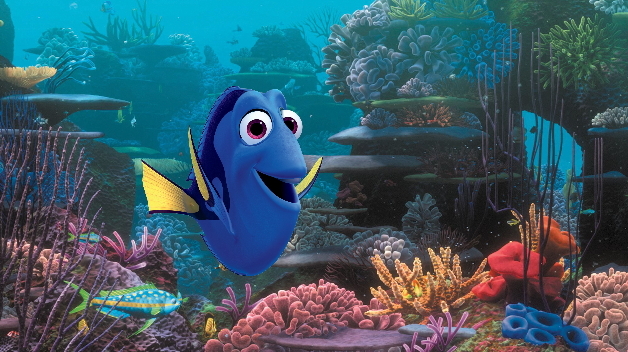Unforgettable. That’s how fans felt about Disney’s 2003 hit “Finding Nemo,” and about the film’s breakout supporting character, the infectiously energetic and forgetful blue tang Dory, voiced by Ellen DeGeneres. So unforgettable that anticipation is at a fever pitch for the sequel 13 years in the making, “Finding Dory.” It’s safe to say that fans will be delighted to be reunited with these characters in this charming and heartwarming voyage under (and above) the sea.
“Finding Nemo” writer/director Andrew Stanton returns to helm the good ship “Dory” (Angus McClane co-directs), which takes on Dory’s life story, even though she has a hard time remembering it. Dory is determined to return to her home and find her loving parents, Jenny (Diane Keaton) and Charlie (Eugene Levy), when some of her long-lost memories resurface.
 |
Dory (Ellen DeGeneres) is a wide-eyed, blue tang fish who suffers from memory loss and sets out to find her parents. (Walt Disney Studios Motion Pictures) |
So it’s back across the ocean Dory goes, with buddies Marlin (Albert Brooks) and Nemo (Hayden Rolence) in tow. They end up at the Morro Bay Marine Life Institute, where the voice of Sigourney Weaver announces that they “rescue, rehabilitate and release” the ocean’s sickly critters. Memories come flooding back, but before she can even devise a plan, Dory’s scooped up, tagged, brought inside the facility, and separated from Marlin and Nemo.
Of course, drama has to be wrought from harrowing separations and just-missed connections, and those drive the engine of the story. Dory makes her way through the aquarium with the help of her new friend Hank the grumpy octopus (Ed O’Neill) and her old pipe pal Destiny the whale shark (Kaitlin Olson), as well as Bailey the beluga (Ty Burrell). For a film about fish, a lot of the action takes place on land, which offers a whole new set of obstacles and complications.
One of the most impressive aspects of “Finding Dory” is the way in which it celebrates those who are differently-abled. Dory, as you may remember, has short term memory loss, which impacts her ability to do much of anything, really. She can only focus on what’s in front of her, and has to rely on her friends and their goodwill to help her out. But the film firmly asserts the message that no one needs to apologize for the way their brain works, and that anyone can do anything they set their mind to -- they just might have to do it a little bit differently. It’s an empowering message for any person.
The animation itself is spectacular, as to be expected, with colorful, fantastical underwater worlds that aren’t realistic, necessarily, but wondrously imaginative. The animated short that precedes the film, “Piper,” also features amazingly photorealistic animation and an incredibly cute main character.
 |
A scene from “Finding Dory” (Walt Disney Studios Motion Pictures) |
The beating heart of “Finding Dory” is one that’s a lot like its protagonist -- warm, inviting, open and inclusive. As Marlin and Nemo search for their friend, they stop trying to think their way and ask themselves, “What would Dory do?” Dory herself makes a friend out of any fish she encounters.
Stanton and Disney excel at the type of sentiment that burrows itself into your heart and won’t let go, pulling the heartstrings connected to home, family, friends and community. In a world that can feel isolating and alienating at times, somehow a goofy and forgetful fish like Dory can remind us just how far a friendly face and asking for help can go. (TNS)
By Katie Walsh
Tribune News Service






![[Exclusive] Hyundai Mobis eyes closer ties with BYD](http://res.heraldm.com/phpwas/restmb_idxmake.php?idx=644&simg=/content/image/2024/11/25/20241125050044_0.jpg)
![[Herald Review] 'Gangnam B-Side' combines social realism with masterful suspense, performance](http://res.heraldm.com/phpwas/restmb_idxmake.php?idx=644&simg=/content/image/2024/11/25/20241125050072_0.jpg)

